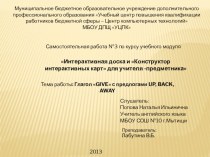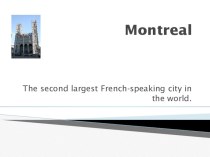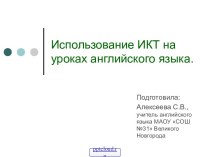- Главная
- Разное
- Бизнес и предпринимательство
- Образование
- Развлечения
- Государство
- Спорт
- Графика
- Культурология
- Еда и кулинария
- Лингвистика
- Религиоведение
- Черчение
- Физкультура
- ИЗО
- Психология
- Социология
- Английский язык
- Астрономия
- Алгебра
- Биология
- География
- Геометрия
- Детские презентации
- Информатика
- История
- Литература
- Маркетинг
- Математика
- Медицина
- Менеджмент
- Музыка
- МХК
- Немецкий язык
- ОБЖ
- Обществознание
- Окружающий мир
- Педагогика
- Русский язык
- Технология
- Физика
- Философия
- Химия
- Шаблоны, картинки для презентаций
- Экология
- Экономика
- Юриспруденция
Что такое findslide.org?
FindSlide.org - это сайт презентаций, докладов, шаблонов в формате PowerPoint.
Обратная связь
Email: Нажмите что бы посмотреть
Презентация на тему История Симферополя в памятниках
Содержание
- 2. Prince Vasyli Mikhailovich Dolgorukov-KrymskyPrince Vasyli Dolgorukov (1722-1782)
- 3. Dolgorukovsky obelisk is a monument of the
- 4. Alexander Vasilyevich SuvorovAlexander Vasilyevich Suvorov ( 1729-1800)
- 5. Monument to Alexander SuvorovThe monument to Suvorov
- 6. Catherine II (1729–1796), also known as Catherine
- 7. The author of the first monument to
- 9. Monument to Alexander
- 11. Monument to Taras ShevchenkoThe memorial was established
- 12. Piotr Ilyich Tchaikovsky Piotr Ilyich Tchaikovsky (
- 13. Monument to Piotr Ilyich TchaikovskyThe monument
- 14. Vladimir Ilyich LeninVladimir Ilyich Ulyanov, better
- 15. The monument to Lenin was erected in
- 16. Konstantin Andreevich Trenev (1876-1945) was a Soviet
- 17. Monument to TrenevThe park named after Trenev
- 18. During the Great Patriotic War the Crimean
- 19. Monument to partisans and underground fighters of
- 20. Bogdan Khmelnitsky ( 1595-1657) was a Ukrainian Hetman of the Zaporozhian
- 21. Monument to Bohdan KhmelnitskyThe monument was erected
- 22. Vladimir Vysotsky Vladimir Vysotsky is a Soviet
- 23. Скачать презентацию
- 24. Похожие презентации
Prince Vasyli Mikhailovich Dolgorukov-KrymskyPrince Vasyli Dolgorukov (1722-1782) was a general of the Russian Empire and Governor-General of Moscow from 1780-1782. He was a senior military commander of the Russo-Turkish War (1768–1774). His army seized Crimea by

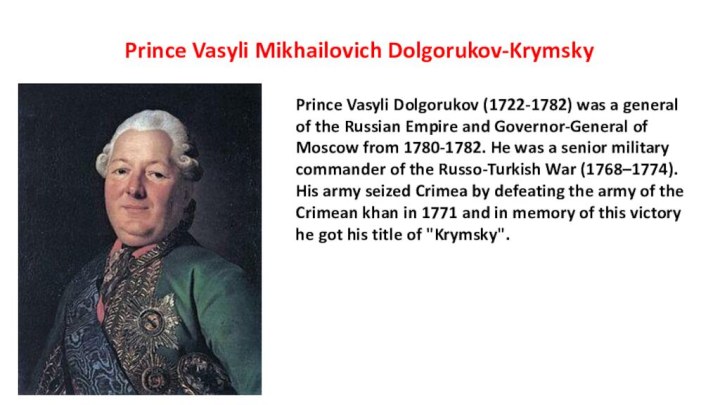
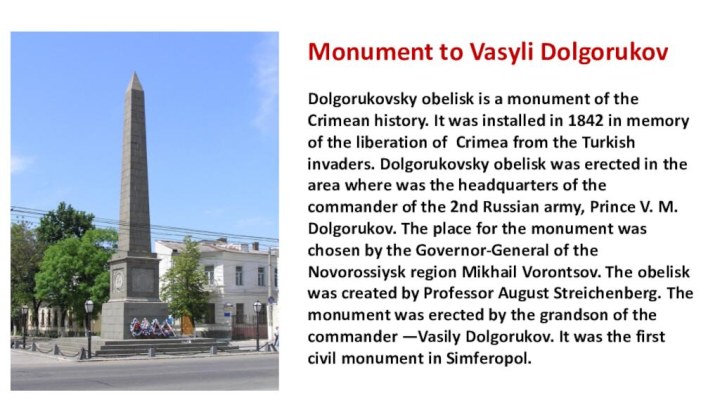

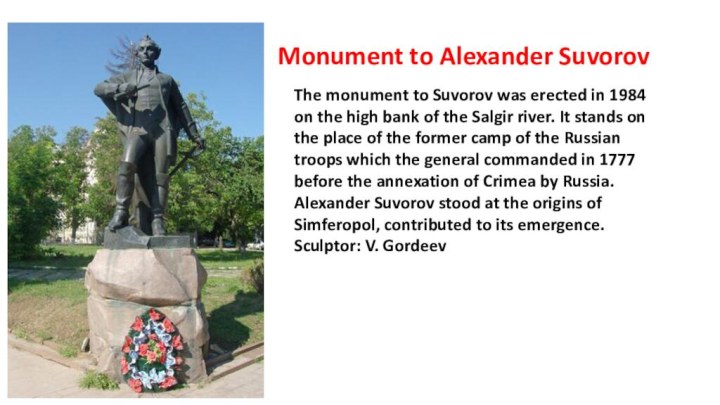










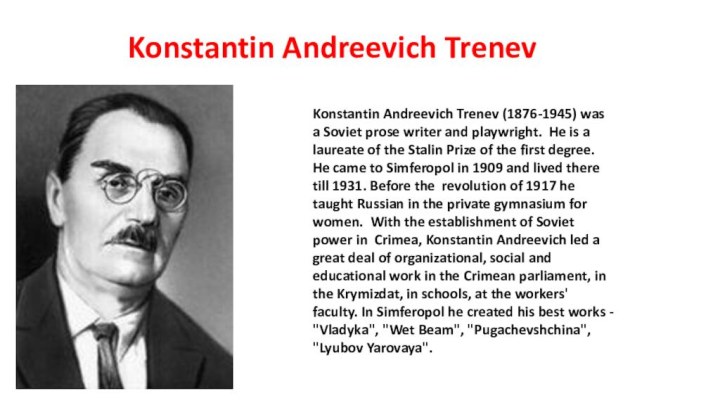
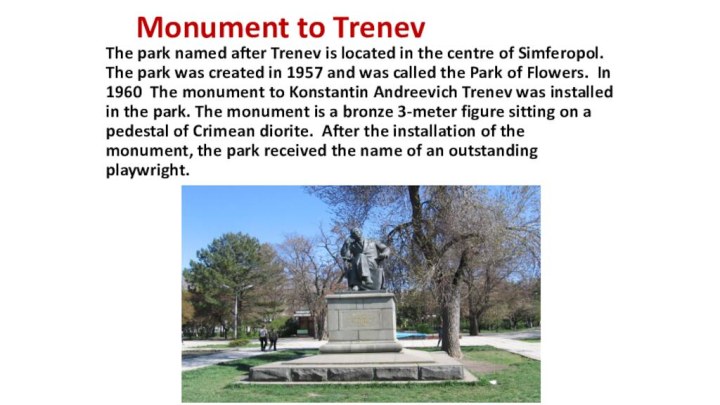

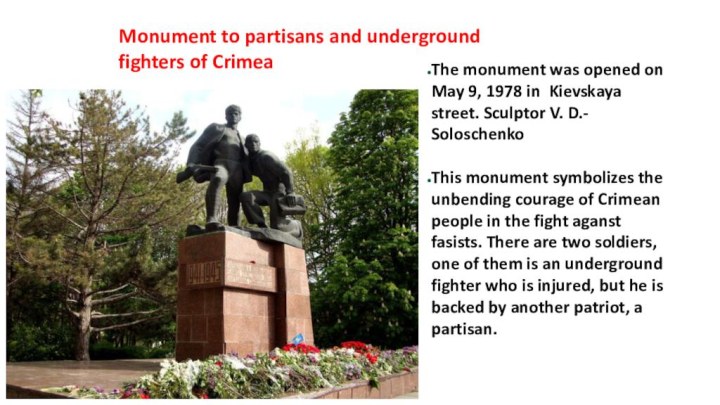




Слайд 3 Dolgorukovsky obelisk is a monument of the Crimean
history. It was installed in 1842 in memory of
the liberation of Crimea from the Turkish invaders. Dolgorukovsky obelisk was erected in the area where was the headquarters of the commander of the 2nd Russian army, Prince V. M. Dolgorukov. The place for the monument was chosen by the Governor-General of the Novorossiysk region Mikhail Vorontsov. The obelisk was created by Professor August Streichenberg. The monument was erected by the grandson of the commander —Vasily Dolgorukov. It was the first civil monument in Simferopol.Monument to Vasyli Dolgorukov
Слайд 4
Alexander Vasilyevich Suvorov
Alexander Vasilyevich Suvorov ( 1729-1800) is
a Russian military commander, founder of the national military
theory, national hero of Russia. He is considered to be one of the few generals in history who never lost a battle. He commanded the Russian troops in the Crimea from 1776 to 1784 during Russo-Turkish wars.
Слайд 5
Monument to Alexander Suvorov
The monument to Suvorov was
erected in 1984 on the high bank of the
Salgir river. It stands on the place of the former camp of the Russian troops which the general commanded in 1777 before the annexation of Crimea by Russia. Alexander Suvorov stood at the origins of Simferopol, contributed to its emergence. Sculptor: V. GordeevСлайд 6 Catherine II (1729–1796), also known as Catherine the
Great, was Empress of Russia from 1762 until 1796.
Under her reign, Russia grew larger and stronger, and was recognized as one of the greatest powers of Europe. Catherine reformed the administration of Russian guberniyas, and many new cities and towns were founded on her orders. During her reign Crimea was annexed by Russia as the result of Russo- Turkish wars in 1773. In 1787 she travelled to Crimea. She visited such towns as Bakhchisaray, Sevastopol, Feodosia and Simferopol. In memory of her staying in Simferopol the monument was erected in 1890 .Catherine the Great
Слайд 7 The author of the first monument to Empress
Catherine the Great was an academician of the Imperial
Academy of Arts N. A. Laveretsky. The construction of the monument was timed to the centennial of the annexation of Crimea to Russia. The work was carried out on public donations. The bronze monument was erected in 1890 on the site of the gardens. The monument was dismantled by the Soviet authorities in May 1921. In 2014, after the annexation of Crimea to the Russian Federation, the monument was restored and opened again in 2016.Monument to Catherine the Great
Слайд 8
Alexander Sergeysvich Pushkin
Alexander Sergeyevich Pushkin ( 1799 – 1837) was a Russian poet, playwright, and novelist of the Romantic era who
is considered by many to be the greatest Russian poet and the founder of modern Russian literature. In 1820 he came to Crimea together with the family of general Raevsky. His son Nicholas was Pushkin’s friend. Pushkin liked Crimea very much. He wrote to his brother that he had the happiest moments in his life there. The poet visited some towns in Crimea: Kerch, Feodosia, Bakhchisaray and at the end of his journey he spend a week in Simferopol
Слайд 9
Monument to Alexander Pushkin
The
monument is located in the center of the city
at the intersection of Gorky and Pushkin streets near Russian Drama Theater. It was established in memory of Pushkin’s visit to Simferopol in 1920, when the poet returned from a journey along the southern coast of the Crimea.The authors of the monument are the architect Melik-Parsadanov and the sculptor Kovalev. It was established in 1967.
Слайд 10 Taras
Shevchenko
Taras Shevchenko (1814-1861) was a Ukrainian poet, writer, artist, public and
political figure, as well as folklorist and ethnographer. His literary heritage is regarded to be the foundation of modern Ukrainian literature and, to a large extent, the modern Ukrainian language. Shevchenko is also known for many masterpieces as a painter and an illustrator.His most famous collection of poems is «Kobzar» and the most famous painting is «Katerina» which are known all over the world.
Слайд 11
Monument to Taras Shevchenko
The memorial was established in
1997 at the entrance of Shevchenko park, in Sevastopolskaya
street.It was a present to Simferopol from the city Kalush (Ivanovsky region in Ukraine). The park was founded in 1924 and then it was called Trade Union park. The park was renamed in 1964 by the centenary of Shevchenko’s birthday because at that time Crimea was a part of the Ukrainian Soviet Socialist Republic.
Слайд 12
Piotr Ilyich Tchaikovsky
Piotr Ilyich Tchaikovsky ( 1840-1893)
went down in history as an outstanding Russian composer
of the romantic period. He wrote popular concertos, ballets, symphonies, operas and chamber music. Some of his works have made the list of the most famous compositions in the classical repertoire. Pyotr Tchaikovsky is considered the first Russian composer who produced a strong impression internationally. His most famous operas are "The Queen of Spades" - based on A.S. Pushkin's The Queen of Spades (1890), "Cherevichki" is an opera based on the novel by N.V. Gogol's "The Night Before Christmas" (1885), "Eugene Onegin" - for the novel of the same name in verse A.S. Pushkin (1878).
Слайд 13
Monument to Piotr Ilyich Tchaikovsky
The monument to
Piotr lliych Tchaikovsky was installed in 1986 at the
Concert Hall of the Musical College bearing the name of the great composer. Sculptor: Viktor Sergeevich Gordeev. It shows the composer standing near the piano.
Слайд 14
Vladimir Ilyich Lenin
Vladimir Ilyich Ulyanov, better known
as V. I.Lenin
(1870- 1924), was a Russian communist revolutionary, politician and political theorist.
He served as head of government of Soviet Russia from 1917 to 1924 and of the Soviet Union from 1922 to 1924. Under his administration, Russia and then the wider Soviet Union became a one-party communist state governed by the Russian Communist Party. Ideologically a Marxist, he developed political theories known as Leninism. He greatly influenced over the international communist movement.Слайд 15 The monument to Lenin was erected in honor
of the Russian revolutionary leader Vladimir Ilyich Ulyanov. The
grand opening took place in 1967. The total height of the monument is more than 10 meters. It is installed in Lenin square. There the words are carved: "The monument to Vladimir Ilyich was built in the year of the 50th anniversary of the Great October Socialist Revolution by the workers of Simferopol" . Monument to Vladimir Lenin
Слайд 16 Konstantin Andreevich Trenev (1876-1945) was a Soviet prose
writer and playwright. He is a laureate of the
Stalin Prize of the first degree. He came to Simferopol in 1909 and lived there till 1931. Before the revolution of 1917 he taught Russian in the private gymnasium for women. With the establishment of Soviet power in Crimea, Konstantin Andreevich led a great deal of organizational, social and educational work in the Crimean parliament, in the Krymizdat, in schools, at the workers' faculty. In Simferopol he created his best works - "Vladyka", "Wet Beam", "Pugachevshchina", "Lyubov Yarovaya".Konstantin Andreevich Trenev
Слайд 17
Monument to Trenev
The park named after Trenev is
located in the centre of Simferopol. The park was
created in 1957 and was called the Park of Flowers. In 1960 The monument to Konstantin Andreevich Trenev was installed in the park. The monument is a bronze 3-meter figure sitting on a pedestal of Crimean diorite. After the installation of the monument, the park received the name of an outstanding playwright.Слайд 18 During the Great Patriotic War the Crimean partisans
fought heroically with the German-fascist invaders. By the beginning
of November 1941 the number of crimean partisans squads was about 29. But in 1944 there were around 220 underground organisations.Some of the bravest fighters were A.V.Mokrousov, Alime Abdennanova, Chub Mihail, Bedin Ivan and Leonov Fedor
In total during the war, patriots destroyed and captured over 33,000 enemy soldiers and officers, destroyed 79 military echelons, 2 armored trains, dozens of fuel and ammunition depots, blew up 3 railway bridges and captured many trophies.
Partisans and underground fighters of Crimea
Слайд 19
Monument to partisans and underground fighters of Crimea
The
monument was opened on May 9, 1978 in Kievskaya
street. Sculptor V. D.- SoloschenkoThis monument symbolizes the unbending courage of Crimean people in the fight aganst fasists. There are two soldiers, one of them is an underground fighter who is injured, but he is backed by another patriot, a partisan.
Слайд 20 Bogdan Khmelnitsky ( 1595-1657) was a Ukrainian Hetman of the Zaporozhian Host,
prominent Ukrainian politician and military leader. In 1654, he concluded
the Treaty of Pereyaslav about reunification of Ukrainian lands with Russia. Khmelnitsky had a crucial influence on the history of Ukraine. In Ukraine, Khmelnitsky is generally regarded as a national hero.Bohdan Khmelnitsky

















